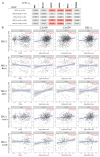Noscapine and Apoptosis in Breast and Other Cancers
- PMID: 38542508
- PMCID: PMC10970989
- DOI: 10.3390/ijms25063536
Noscapine and Apoptosis in Breast and Other Cancers
Abstract
Breast cancer is the second leading contributor to the age-standardized mortality rate, for both sexes and all ages worldwide. In Europe and the United States, it is the second leading cause of mortality, with an incidence rate of about 2.6 million cases per year. Noscapine, a well-known alkaloid used as a cough suppressant, demonstrated anti-tumor effects by triggering apoptosis in various cancer cell lines and has the potential to become another ally against breast, ovarian, colon, and gastric cancer, among other types of malignancy. Apoptosis plays a crucial role in the treatment of cancer. Noscapine affected BAX, CASP8, CASP9, NFKBIA, and RELA gene and protein expression in the MCF-7 and MDA-MB-231 cell lines. Gene expression was higher in tumor than in normal tissue, including the BAX expression levels in lung, ovary, endometrium, colon, stomach, and glioblastoma patients; BCL2L1 expression in endometrium, colon, and stomach patients; CASP8 gene expression levels in lung, endometrium, colon, stomach, and glioblastoma patients; RELA in colon, stomach, and glioblastoma patients; and NFKBIA in glioblastoma patients. It can be concluded that noscapine affected genes and proteins related to apoptosis in cancer cell lines and several types of cancer patients.
Keywords: Bax; Bcl-2; apoptosis; breast cancer; caspase-8; caspase-9; noscapine.
Conflict of interest statement
The authors declare no conflicts of interest The funders had no role in the design of the study; in the collection, analyses, or interpretation of data; in the writing of the manuscript; or in the decision to publish the results.
Figures







References
-
- IARC Cancer Today: Estimated Age-Standardized Incidence and Mortality Rates (World) in 2020. International Agency for Research on Cancer 2023. [(accessed on 22 August 2023)]. Available online: https://gco.iarc.fr/today/
-
- NIH Risk Factors for Cancer National Cancer Institute. [(accessed on 6 February 2024)]; Available online: https://www.cancer.gov/about-cancer/causes-prevention/risk.
Publication types
MeSH terms
Substances
Grants and funding
LinkOut - more resources
Full Text Sources
Medical
Research Materials
Miscellaneous

